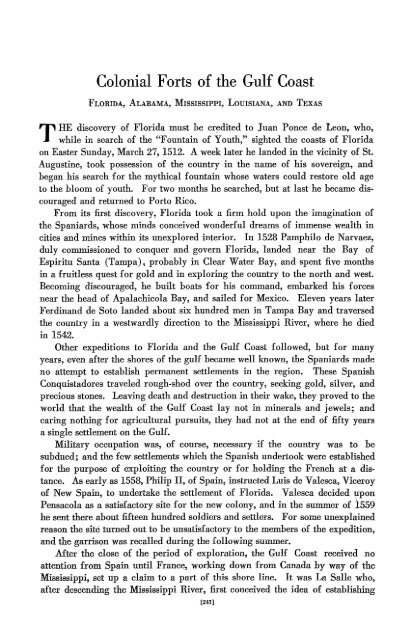THE COAST ARTILLERY JOURNAL - Air Defense Artillery
THE COAST ARTILLERY JOURNAL - Air Defense Artillery
THE COAST ARTILLERY JOURNAL - Air Defense Artillery
Create successful ePaper yourself
Turn your PDF publications into a flip-book with our unique Google optimized e-Paper software.
Colonial Forts of the Gulf Coast<br />
FLORIDA, ALABAMA, MISSISSIPPI, LOUISIANA, AND TEXAS<br />
<strong>THE</strong> discovery of Florida must be credited to Juan Ponce de Leon, who,<br />
while in search of the "Fountain of Youth," sighted the coasts of Florida<br />
on Easter Sunday, March 27, 1512. A week later he landed in the vicinity of St.<br />
Augustine, took possession of the country in the name of his sovereign, and<br />
began his search for the mythical fountain whose waters could restore old age<br />
to the bloom of youth. For two months he searched, but at last he became discouraged<br />
and returned to Porto Rico.<br />
From its first discovery, Florida took a firm hold upon the imagination of<br />
the Spaniards, whose minds conceived wonderful dreams of immense wealth in<br />
cities and mines within its unexplored interior. In 1528 Pamphilo de Narvaez,<br />
duly commissioned to conquer and govern Florida, landed near the Bay of<br />
Espiritu Santa (Tampa), probably in Clear Water Bay, and spent five months<br />
in a fruitless quest for gold and in exploriug the country to the north and west.<br />
Becoming discouraged, he built boats for his command, embarked his forces<br />
near the head of Apalachicola Bay, and sailed for Mexico. Eleven years later<br />
Ferdinand de Soto landed about six hundred men in Tampa Bay and traversed<br />
the country in a westwardly direction to the Mississippi River, where he died<br />
in 1542.<br />
Other expeditions to Florida and the Gulf Coast followed, but for many<br />
years, even after the shores of the gulf became well known, the Spaniards made<br />
no attempt to establish permauent settlements in the region. These Spanish<br />
Conquistadores traveled rough-shod over the country, seeking gold, silver, and<br />
precious stones. Leaving death and destruction in their wake, they proved to the<br />
world that the wealth of the Gulf Coast lay not in minerals and jewels; and<br />
caring nothing for agricultural pursuits, they had not at the end of fifty years<br />
a single settlement on the Gulf.<br />
Military occupation was, of course, necessary if the country was to be<br />
subdued; and the few settlements which the Spanish undertook were established<br />
for the purpose of exploiting the country or for holding the French at a distance.<br />
As early as 1558, Philip II, of Spain, instructed Luis de Valesca, Viceroy<br />
of New Spain, to undertake the settlement of Florida. Valesca decided vpon<br />
Pensacola as a satisfactory site for the new colony, and in the summer of i559<br />
he sent there about fifteen hundred soldiers and settlers. For some unexplained<br />
reason the site turned out to be unsatisfactory to the members of the eXpedition,<br />
and the garrison was recalled during the following summer.<br />
Mter the close of the period of exploration, the Gulf Coast received no<br />
attention from Spain until France, working down from Canada by way of the<br />
Mississippi, set up a claim to a part of this shore line. It was La Salle who,<br />
after descending the Mississippi River, first conceived the idea of establishing<br />
[2~3]
















